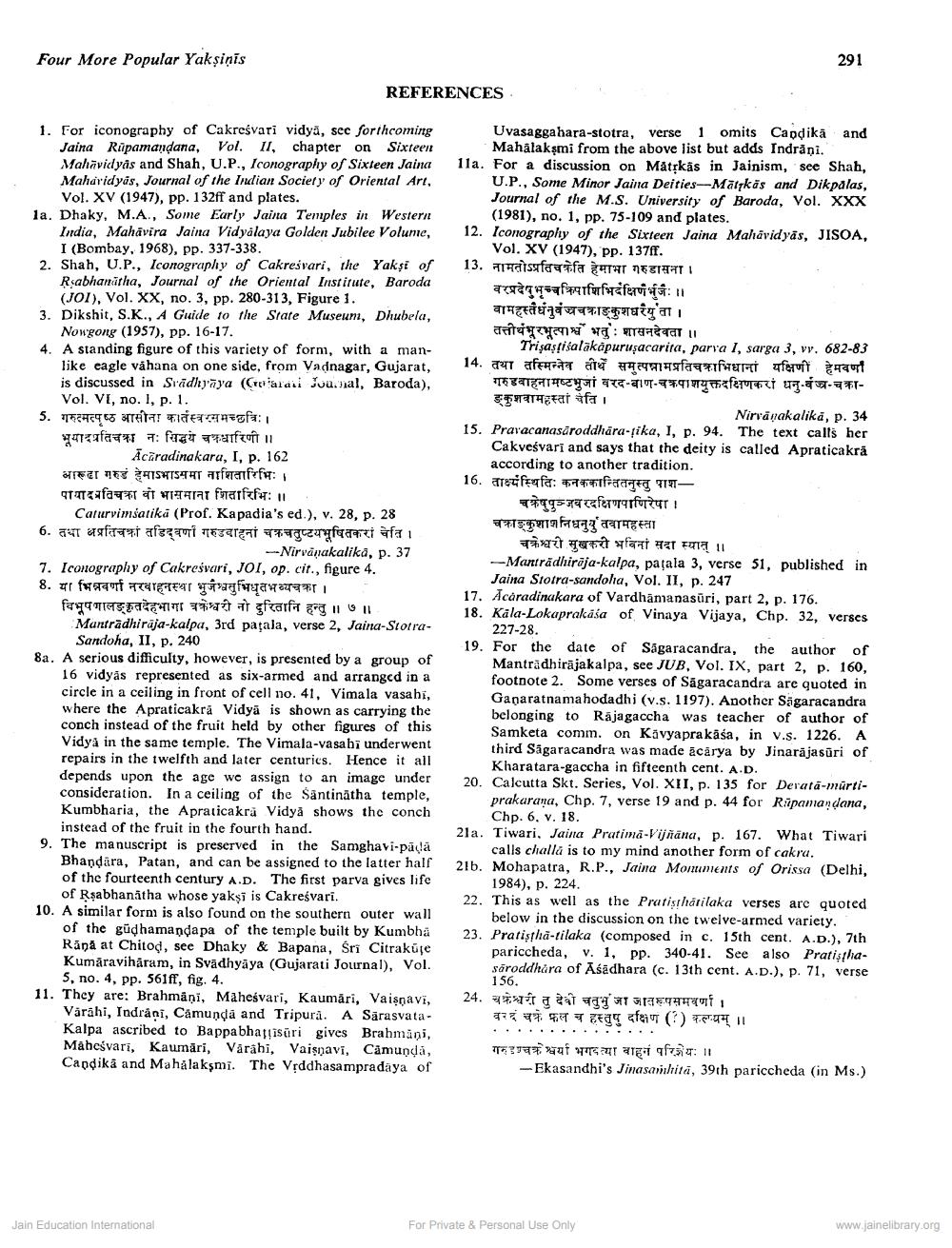________________
Four More Popular Yakṣiņis
1. For iconography of Cakreśvari vidya, see forthcoming Jaina Rupamaṇḍana, Vol. II, chapter on Sixteen Mahavidyas and Shah, U.P., Iconography of Sixteen Jaina Mahavidyas, Journal of the Indian Society of Oriental Art, Vol. XV (1947), pp. 132ff and plates.
REFERENCES
la. Dhaky, M.A., Some Early Jaina Temples in Western India, Mahavira Jaina Vidyalaya Golden Jubilee Volume, I (Bombay, 1968), pp. 337-338.
2. Shah, U.P., Iconography of Cakresvari, the Yaksi of Rabhanatha, Journal of the Oriental Institute, Baroda (JOI), Vol. XX, no. 3, pp. 280-313, Figure 1.
3. Dikshit, S.K., A Guide to the State Museum, Dhubela, Nowgong (1957), pp. 16-17.
4. A standing figure of this variety of form, with a manlike eagle våhana on one side, from Vadnagar, Gujarat, is discussed in Sradhyaya (Carati Jounal, Baroda), Vol. VI, no. 1, p. 1.
5. गरुत्मत्पृष्ठ आसीना कार्तस्वरसमच्छत्रिः ।
भूयादप्रतिचक्रा नः सिद्धये चक्रधारिणी ।
Acaradinakara, I, p. 162
आरूढा गरुडं हेमाडभाइसमा नाशितारिभिः । पायादत्रविचका वो भासमाना शितारिभिः ॥
Caturvimsatika (Prof. Kapadia's ed.), v. 28, p. 28 6. तथा प्रतिचक्रां तडिद्वर्णां गरुडवानां चक्रचतुष्टयभूषितकरां चेति । -Nirvanakalika, p. 37 7. Iconography of Cakreśvari, JOI, op. cit., figure 4. 8. या भिन्नवर्णा नरवाहनस्था भुजेश्वतुभिधूतभव्यचक्रा ।
विभूषणालङ्कृतदेहभागा चक्रेश्वरी तो दुरितानि हन्तु ॥ ७ ॥
Manträdhiraja-kalpa, 3rd patala, verse 2, Jaina-StotraSandoha, II, p. 240
8a. A serious difficulty, however, is presented by a group of 16 vidyas represented as six-armed and arranged in a circle in a ceiling in front of cell no. 41, Vimala vasahi, where the Apraticakra Vidya is shown as carrying the conch instead of the fruit held by other figures of this Vidya in the same temple. The Vimala-vasahi underwent repairs in the twelfth and later centuries. Hence it all depends upon the age we assign to an image under consideration. In a ceiling of the Santinatha temple, Kumbharia, the Apraticakra Vidya shows the conch instead of the fruit in the fourth hand.
9. The manuscript is preserved in the Samghavi-pādā Bhandara, Patan, and can be assigned to the latter half of the fourteenth century A.D. The first parva gives life of Ṛsabhanatha whose yakşî is Cakreśvari.
10. A similar form is also found on the southern outer wall of the güdhamandapa of the temple built by Kumbhä Rana at Chitod, see Dhaky & Bapana, Śri Citraküte Kumāravihāram, in Svadhyaya (Gujarati Journal), Vol. 5, no. 4, pp. 561ff, fig. 4.
11. They are: Brahmaņi, Maheśvari, Kaumāri, Vaiṣṇavi, Värähi, Indraṇī, Camunda and Tripura. A SarasvataKalpa ascribed to Bappabhatisüri gives Brahmāņi, Maheśvari, Kaumāri, Varahi, Vaisnavi, Camuṇḍā, Candika and Mahalaksmi. The Vṛddhasampradaya of
Jain Education International
Uvasaggahara-stotra, verse 1 omits Capḍika and Mahalaksmi from the above list but adds Indrāni.
11a. For a discussion on Matṛkäs in Jainism, see Shah, U.P., Some Minor Jaina Deities-Mätykäs and Dikpalas, Journal of the M.S. University of Baroda, Vol. XXX (1981), no. 1, pp. 75-109 and plates.
12. Iconography of the Sixteen Jaina Mahavidyas, JISOA, Vol. XV (1947), pp. 137ff. 13. नामतोऽप्रतिचक्रेति हेमाभा गरुडासना ।
वरप्रदेषुभुच्चक्रिपाशिभिदक्षिणैर्भुजैः ॥ वामहस्तैर्धनुवं ज्ञचत्राङ्कुशधरैर्युता ।
291
तत्तीर्थभूरभूत्पार्श्व भतुः शासनदेवता ॥
Trişaştisalakāpuruşacarita, parva I, sarga 3, vv. 682-83 14. तथा तस्मिन्नेव तीर्थे समुत्पन्नामप्रतिचत्राभिधानां यक्षिणी हेमवर्णा गरुडवानामष्टभुजां वरद बाण चक्रपाणयुक्तदक्षिणकरां धनु-वं चत्राकुशवामहस्तां चेति । Nirvanakalika, p. 34
15. Pravacanasaroddhāra-tika, I, p. 94. The text calls her Cakveśvari and says that the deity is called Apraticakrā according to another tradition.
16. ताक्ष्यंस्थितिः कनककान्तितनुस्तु पाश
g=avceforfeber
चाकुशाश निधनु तवामहस्ता
चक्रेश्वरी सुखकरी भविनां सदा स्यात् ॥
-Manträdhiraja-kalpa, patala 3, verse 51, published in Jaina Stotra-sandoha, Vol. II, p. 247
17. Acȧradinakara of Vardhamanasuri, part 2, p. 176. 18. Käla-Lokaprakasa of Vinaya Vijaya, Chp. 32, verses
227-28.
19. For the date of Sagaracandra, the author of Manträdhirajakalpa, see JUB, Vol. IX, part 2, p. 160, footnote 2. Some verses of Sagaracandra are quoted in Ganaratnamahodadhi (v.s. 1197). Another Sägaracandra belonging to Rajagaccha was teacher of author of Samketa comm. on Kavyaprakāśa, in v.s. 1226. A third Sagaracandra was made acarya by Jinarajasūri of Kharatara-gaccha in fifteenth cent. A.D.
20. Calcutta Skt. Series, Vol. XII, p. 135 for Devata-murtiprakaraṇa, Chp. 7, verse 19 and p. 44 for Rupamaṇḍana, Chp. 6, v. 18.
21a. Tiwari, Jaina Pratima-Vijñāna, p. 167. What Tiwari calls challa is to my mind another form of cakra. 21b. Mohapatra, R.P., Jaina Monuments of Orissa (Delhi,
1984), p. 224.
22. This as well as the Pratisthätilaka verses are quoted below in the discussion on the twelve-armed variety. 23. Pratistha-tilaka (composed in c. 15th cent. A.D.), 7th pariccheda, v. 1, pp. 340-41. See also Pratisthasaroddhara of Asadhara (c. 13th cent. A.D.), p. 71, verse 156.
24. चक्रेश्वरी तु देवी चतुर्भुजा जातरूपसमवर्णा । वरदं चक्रे फल च हस्तुषु दक्षिण (?) कल्प्यम् ॥
चक्रेश्वर्या भगवत्या वाहन परिशेयः ॥
-Ekasandhi's Jinasamhita, 39th pariccheda (in Ms.)
For Private & Personal Use Only
www.jainelibrary.org




